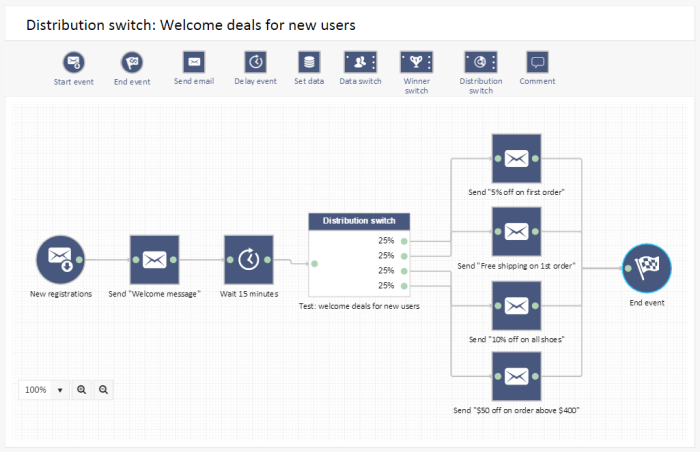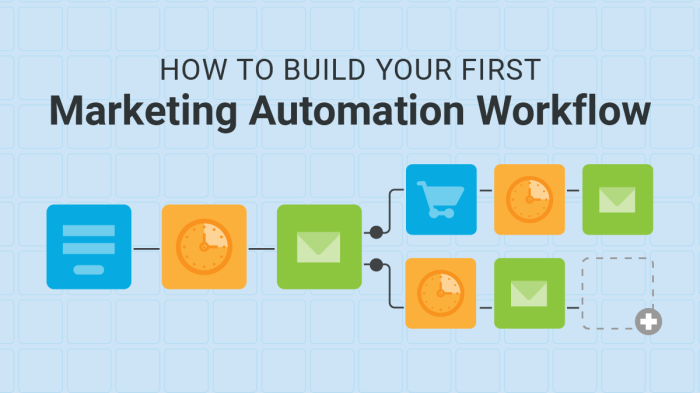Building a Marketing Automation Workflow dives into the world of automated marketing strategies, showcasing how businesses can optimize their efforts efficiently and effectively. From defining the concept to exploring real-life examples, this topic is a must-read for anyone looking to revolutionize their marketing approach.
Planning, executing, and optimizing your workflow has never been more crucial in today’s fast-paced digital landscape. Let’s explore the ins and outs of creating a seamless automated marketing system that drives results and boosts engagement.
Introduction to Marketing Automation Workflow: Building A Marketing Automation Workflow
A marketing automation workflow is a series of automated actions that businesses can set up to streamline and optimize their marketing processes. This includes sending targeted emails, nurturing leads, scoring prospects, and more.
Implementing a marketing automation workflow can bring numerous benefits to businesses, such as saving time, improving efficiency, increasing lead generation, enhancing customer engagement, and ultimately boosting sales and revenue.
Examples of Successful Marketing Automation Workflows in Businesses
- Amazon: Amazon uses marketing automation to recommend products to customers based on their browsing and purchasing history. This personalized approach helps increase sales and customer loyalty.
- HubSpot: HubSpot’s marketing automation workflows include lead nurturing sequences, email campaigns, and lead scoring systems that help businesses attract and convert leads more effectively.
- Salesforce: Salesforce leverages marketing automation to send targeted content to leads at different stages of the sales funnel, ensuring a personalized and relevant experience for each prospect.
Planning Your Marketing Automation Workflow
When it comes to setting up a killer marketing automation workflow, planning is key. You can’t just dive in headfirst without a solid strategy in place. Let’s break down the importance of planning and the key elements to consider when mapping out your automation journey.
Identifying Key Elements
- Define your goals: Before anything else, you need to have a clear understanding of what you want to achieve with your marketing automation. Whether it’s lead generation, customer retention, or increasing sales, knowing your end goal is crucial.
- Know your audience: Understanding your target audience is essential for creating personalized and effective marketing campaigns. Segment your audience based on demographics, behaviors, and interests to tailor your messages accordingly.
- Map out the customer journey: Plot out the different touchpoints a customer goes through from awareness to conversion. This will help you identify where automation can streamline processes and improve user experience.
- Select the right tools: Choose a marketing automation platform that aligns with your goals and budget. Look for features like email marketing, lead scoring, and analytics to track and optimize your campaigns.
Aligning with Marketing Goals, Building a Marketing Automation Workflow
It’s crucial to align your marketing automation workflow with your overall marketing goals. Make sure each step in the workflow contributes to achieving your objectives and resonates with your target audience.
- Set measurable KPIs: Establish key performance indicators to track the success of your automation efforts. Whether it’s click-through rates, conversion rates, or ROI, measuring your results is essential for continuous improvement.
- Iterate and optimize: Don’t set it and forget it. Regularly review your workflow, analyze performance data, and make adjustments to improve results. Continuously optimizing your automation workflow is key to staying ahead of the game.
Building Blocks of a Marketing Automation Workflow
In order to create an effective marketing automation workflow, there are several essential components that need to be considered. These building blocks play a crucial role in ensuring the success of your automation strategy.
Customer Segmentation
Customer segmentation is a key component of a marketing automation workflow as it involves dividing your audience into groups based on specific criteria such as demographics, behavior, or interests. By segmenting your customers, you can create targeted and personalized campaigns that are more relevant to their needs and preferences. This helps in improving engagement and driving conversions.
- Segmentation allows you to tailor your messaging to different audience segments, increasing the likelihood of resonating with them.
- It helps in delivering the right content to the right people at the right time, leading to higher open rates and click-through rates.
- Segmentation enables you to track and analyze the behavior of different customer groups, allowing you to refine your marketing strategies for better results.
Customer segmentation is the foundation of a successful marketing automation workflow, helping you to personalize your communications and build stronger relationships with your audience.
Personalized Content
Personalized content is another crucial building block of a marketing automation workflow. By creating content that is tailored to the individual needs and preferences of your customers, you can increase engagement, build trust, and drive conversions.
- Personalization involves using customer data to deliver relevant content, offers, and recommendations to each individual.
- It helps in creating a more personalized experience for customers, making them feel valued and understood by your brand.
- Personalized content can lead to higher conversion rates as it resonates better with the recipient, prompting them to take action.
Personalized content is essential in marketing automation workflows as it allows you to connect with your audience on a deeper level, driving better results and ROI.
Setting Up Automation Tools
When it comes to setting up automation tools for your marketing workflow, you have a variety of options to choose from in the market. Each tool offers unique features and capabilities that can help streamline your processes and improve efficiency.
Comparing Marketing Automation Tools
- HubSpot: Known for its user-friendly interface and comprehensive features, HubSpot offers a wide range of tools for email marketing, lead generation, and more.
- ActiveCampaign: With powerful automation features and detailed reporting, ActiveCampaign is a popular choice for businesses looking to personalize their marketing efforts.
- Mailchimp: Ideal for small businesses and startups, Mailchimp offers easy-to-use automation tools for email marketing and audience segmentation.
Step-by-Step Guide to Setting Up Automation Tools
- Choose the right tool based on your business needs and budget.
- Create an account and set up your profile with relevant business information.
- Connect your CRM system or database to the automation tool for seamless data integration.
- Define your goals and objectives for automation to tailor the tool to your specific needs.
- Set up automated workflows, including triggers, actions, and conditions, to automate marketing processes.
Integrating Different Tools for Seamless Automation
Integration is key to creating a seamless automation process. By connecting different tools, you can ensure that data flows smoothly between systems and that your marketing efforts are coordinated and consistent.
- Use APIs or third-party integrations to connect your automation tools with other platforms such as CRM systems, social media channels, and analytics tools.
- Map out the customer journey to identify touchpoints where different tools can work together to deliver personalized and targeted messages.
- Regularly monitor and test your integrations to ensure they are working effectively and troubleshoot any issues that may arise.
Data Management in Marketing Automation

Data plays a crucial role in driving marketing automation decisions. By collecting, organizing, and analyzing data effectively, businesses can tailor their automation workflows to target the right audience with the right message at the right time.
Importance of Data in Marketing Automation
- Data allows businesses to understand customer behavior, preferences, and interactions.
- By leveraging data insights, companies can personalize marketing campaigns for better engagement and conversion rates.
- Accurate data helps in identifying trends, predicting future behaviors, and making informed decisions.
Collecting, Organizing, and Analyzing Data
- Utilize CRM systems, web analytics tools, and marketing automation platforms to collect relevant data.
- Organize data in a centralized database for easy access and analysis.
- Analyze data using segmentation, lead scoring, and campaign performance metrics to optimize automation workflows.
Maintaining Data Accuracy and Relevance
- Regularly clean and update data to ensure accuracy and consistency.
- Implement data validation processes to eliminate duplicates and errors.
- Monitor data quality metrics and establish data governance policies to maintain relevance.
Testing and Optimization
Testing and optimization are crucial steps in ensuring the effectiveness of your marketing automation workflow. By carefully analyzing the results of your tests, you can identify areas for improvement and make necessary adjustments to optimize the workflow for better performance.
Strategies for Optimization
- Regularly monitor key performance indicators (KPIs) to track the success of your automation workflow.
- Use A/B testing to compare different versions of your emails, landing pages, or other automated content to see which performs better.
- Segment your audience based on behavior, demographics, or other criteria to personalize your automation and improve engagement.
- Implement lead scoring to prioritize leads based on their interactions with your automated campaigns.
Tips for Continuous Improvement
- Stay updated on the latest trends and technologies in marketing automation to incorporate new strategies into your workflow.
- Solicit feedback from your audience to understand their preferences and tailor your automation to better meet their needs.
- Regularly review and analyze data to identify bottlenecks or areas of inefficiency in your workflow that can be optimized.
- Collaborate with your team to brainstorm ideas for improving the automation process and implementing innovative solutions.
Compliance and Ethics in Marketing Automation

When it comes to marketing automation, it’s crucial to consider the ethical implications and ensure compliance with data protection regulations. Failure to do so can result in negative consequences for both the business and its customers.
Ethical Considerations in Marketing Automation
- Avoid spamming customers with excessive automated emails or messages. Respect their privacy and only send relevant and valuable content.
- Be transparent about the use of automation in marketing. Clearly communicate how customer data is collected, stored, and used.
- Avoid using deceptive tactics to manipulate customers into making a purchase. Honesty and integrity should be at the core of all marketing efforts.
- Respect unsubscribe requests and promptly remove individuals from automated marketing campaigns when requested.
Importance of Compliance with Data Protection Regulations
- Compliance with data protection regulations such as GDPR and CCPA is essential to protect customer data and privacy.
- Failing to comply with these regulations can result in hefty fines and damage to the reputation of the business.
- Ensure that customer data is stored securely and only used for the purposes for which consent was given.
Examples of Unethical Practices to Avoid in Marketing Automation
- Purchasing email lists without consent from individuals on the list.
- Sending misleading or false information in automated messages to deceive customers.
- Ignoring unsubscribe requests or making it difficult for individuals to opt-out of marketing communications.
- Using customer data for purposes other than what was originally consented to.
